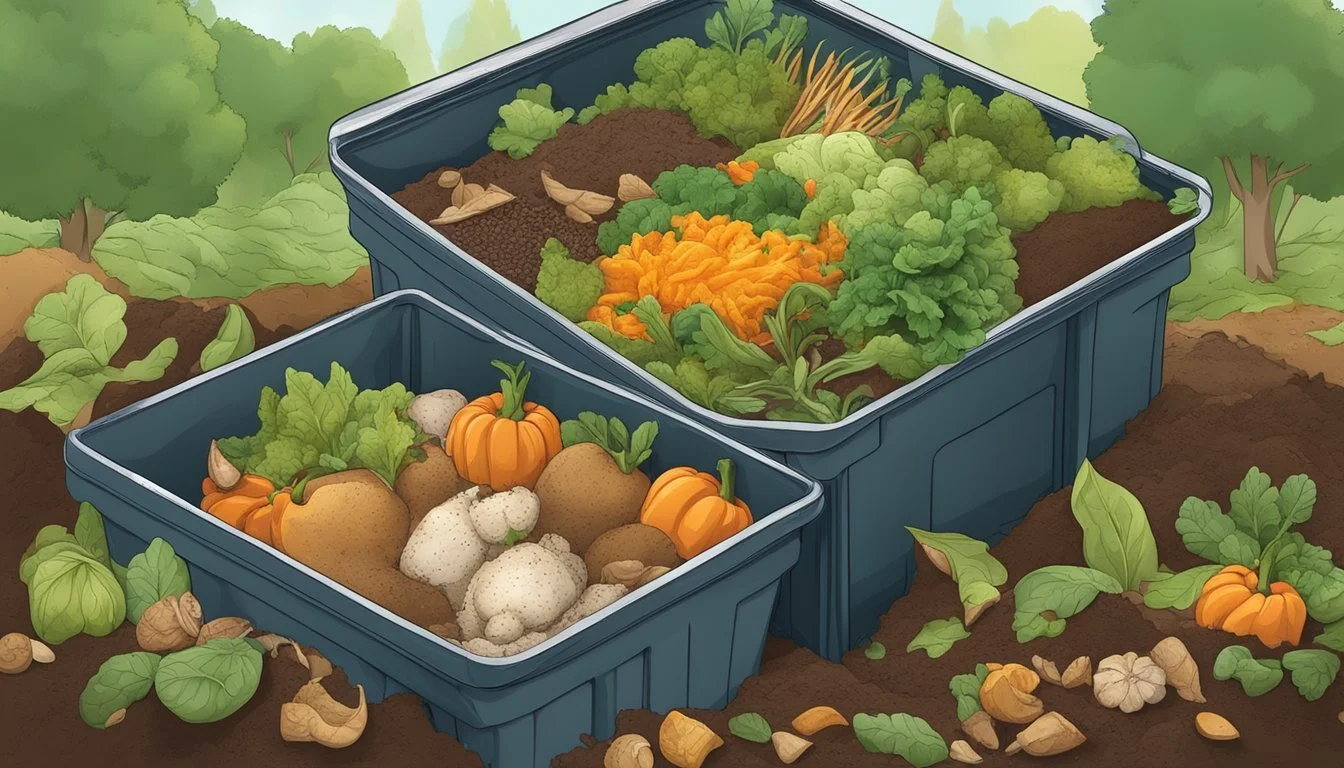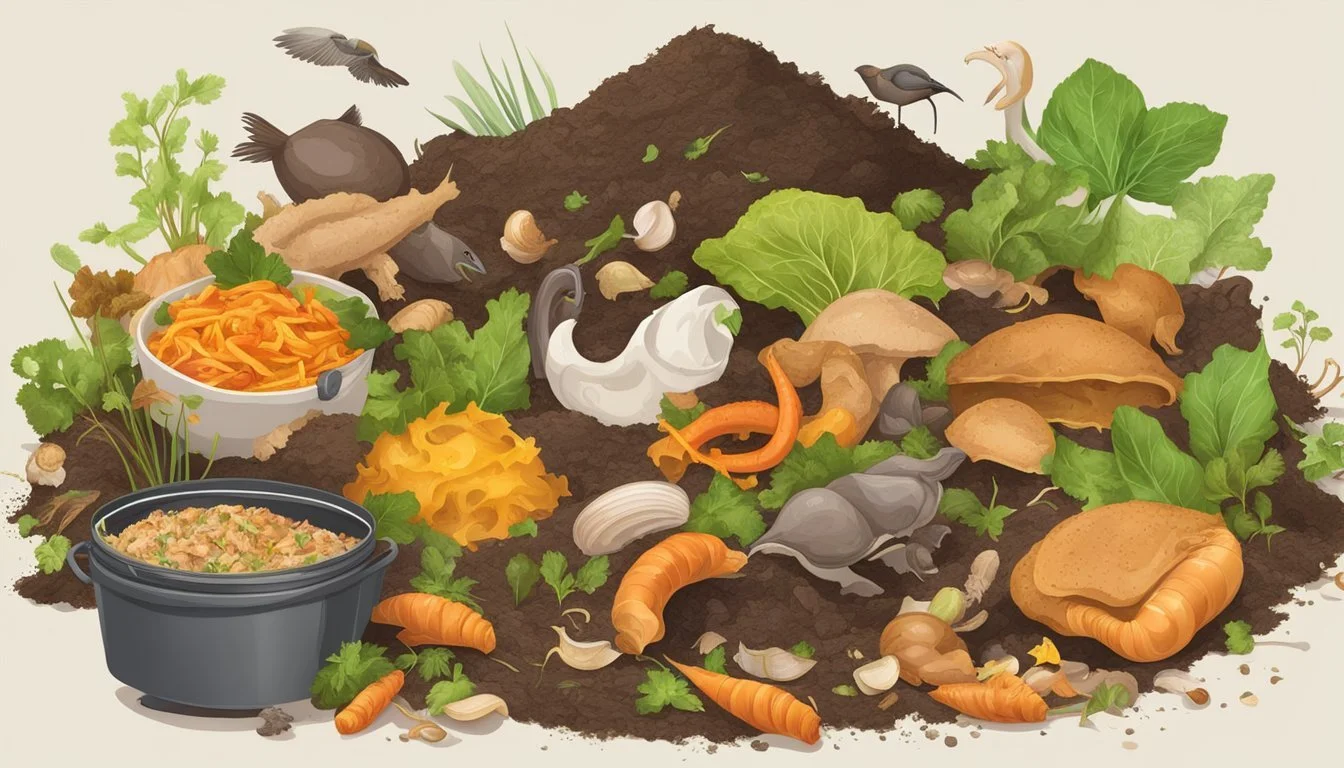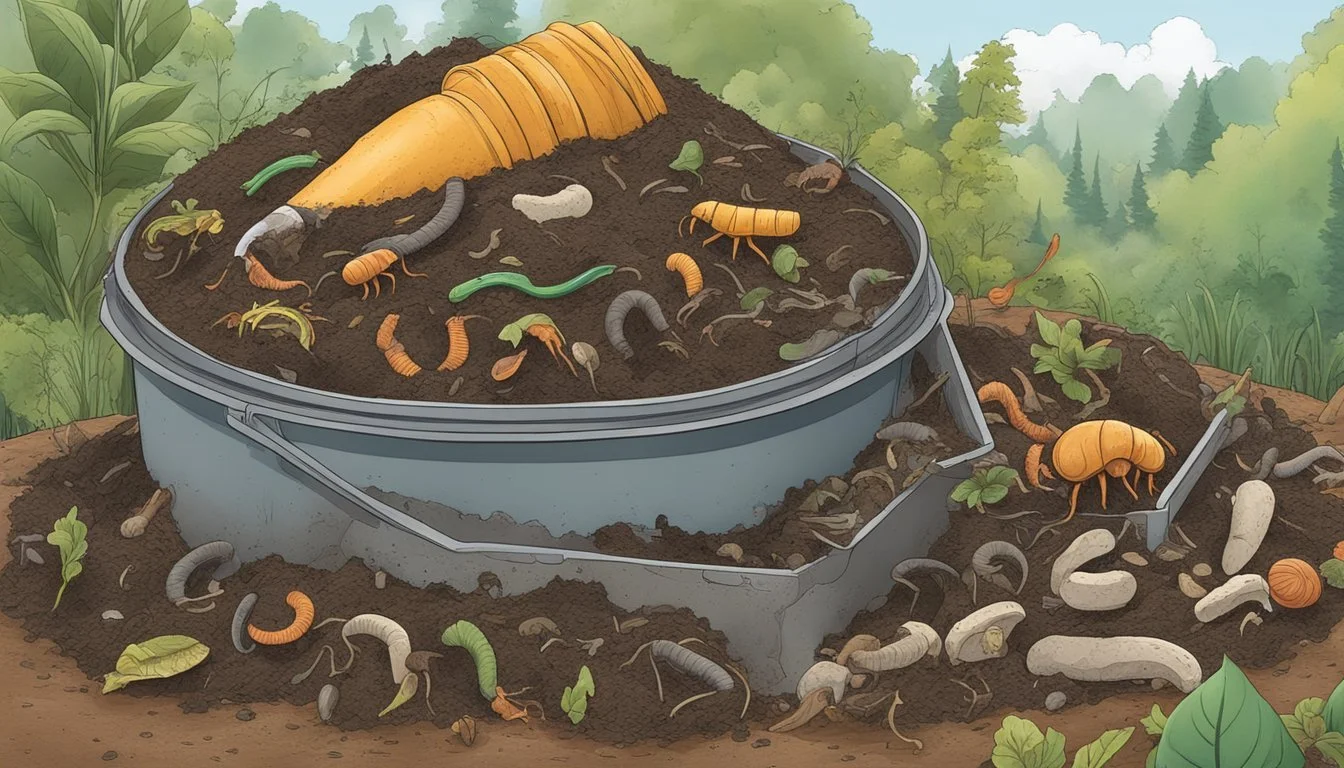Can You Compost Cooked Food?
Understanding Kitchen Waste Recycling
Composting has emerged as a prevalent method for recycling organic waste into a nutrient-rich soil amendment, contributing to sustainable waste management practices. Despite general acceptance of the composting process, the inclusion of cooked foods has been a matter of debate. Traditionally, composting guidelines have advised against adding cooked food to compost piles due to concerns over attracting pests and the complexities of breaking down processed ingredients.
The apprehension surrounding the composting of cooked foods, meats, and dairy is rooted in the challenges they present. These food items can decompose, but they require more careful handling than raw plant materials. Cooked foods are diverse in their composition; items with oils, sugars, or animal products may attract unwanted pests and may break down at different rates, potentially disrupting the composting process.
Nevertheless, composting cooked foods is not implausible; it simply necessitates correct techniques and understanding. Using secure compost bins or containers can prevent scavengers from accessing the waste. It is crucial to maintain an appropriate balance of nitrogen and carbon-rich materials in the compost pile to ensure efficient decomposition and to minimise odours that could attract animals. With these considerations, cooked food can safely be incorporated into a compost system, simultaneously reducing waste and creating a valuable garden resource.
Understanding Composting Basics
The section explores the composting process, highlighting key elements like nitrogen, carbon, oxygen, and moisture that are crucial for successful decomposition of organic matter by microorganisms.
What is Composting?
Composting is the biological decomposition of organic materials by microorganisms into a nutrient-rich soil amendment known as compost. It is a natural process that recycles organic matter, including yard waste and kitchen scraps, into a valuable resource for the environment and gardening.
The Importance of Nitrogen and Carbon
Nitrogen (N) and carbon (C) are fundamental elements in the composting process. Microorganisms require nitrogen for protein synthesis and growth, while carbon acts as an energy source. A balanced C ratio is crucial for effective decomposition:
High Nitrogen Materials: Green plant matter, food scraps.
High Carbon Materials: Dry leaves, straw, wood chips.
For optimal composting, maintain a C ratio between 25:1 and 30:1.
The Role of Oxygen and Moisture
Aerobic microorganisms need oxygen for their metabolic processes to break down organic matter efficiently. Turning the compost pile introduces air and helps maintain oxygen levels.
Adequate Moisture: Compost should feel like a wrung-out sponge.
Avoid Waterlogging: Excess water displaces oxygen, hindering the process.
Both air (oxygen) and moisture (water) must be regulated to sustain a thriving composting environment.
What Can and Cannot Be Composted
In composting, one selects appropriate materials to break down into nutrient-rich soil. The process involves balancing "greens," which provide nitrogen, with "browns," for carbon, to create a healthy compost pile or compost bin. Accuracy in choosing what to compost is crucial for a successful decomposition process.
Compostable Materials
Vegetables and Fruits: Any part of a vegetable or fruit can be composted, including peels, cores, and skins. However, cooked vegetables (how long do cooked vegetables last?) should exclude oils, sauces, and animal products to avoid attracting pests.
Eggshells: Clean and crushed eggshells are compostable. They add calcium to the compost but should be rinsed to remove any egg white remnants.
Leaves: Dead leaves are excellent brown materials for compost and help to balance the carbon-to-nitrogen ratio.
Food Scraps: Most unprocessed food scraps can be composted, with exceptions for those containing oils, dairy, or meat products.
Grass Clippings: Fresh grass clippings are nitrogen-rich and can help heat up the compost pile. They should be mixed with browns to prevent matting.
Tea Bags: Tea bags can be composted if they are made from natural materials; remove any staples or non-compostable labels.
Shredded Paper/Cardboard: These items are suitable as browns in the compost pile. They should be shredded to speed up the breaking down process.
Cooked Rice: (how long does cooked rice last?) Plain cooked rice can be composted, but in moderation, as it may attract pests and should be well-mixed into the compost.
Materials to Avoid in Compost
Diseased Plants: They can spread diseases to future plants grown in the compost.
Pet Wastes: These can harbor pathogens harmful to humans and should never be added.
Meat, Fish, and Dairy Products: These can create odor problems and attract pests to the compost pile.
Fats and Oils: These substances can also attract unwanted pests and take a long time to break down.
By meticulously selecting appropriate items for composting and avoiding harmful materials, composters can ensure a thriving and efficient breakdown process that yields beneficial compost for gardening and plant growth.
Composting Cooked Food
Incorporating cooked food into a composting strategy can be beneficial, yet it warrants careful consideration to avoid potential issues such as pests and odors.
Benefits of Adding Cooked Food to Compost
Adding cooked food to compost can significantly reduce kitchen waste and contribute valuable nutrients to the compost blend. As a nutrient-rich addition, cooked food scraps introduce a diverse range of microorganisms that accelerate the decomposition process. This diversity is vital for a healthy compost heap, as microorganisms play a key role in breaking down organic matter.
Variety of Nutrients: Leftovers can provide a balance of nitrogen and other nutrients that help in the formation of humus.
Waste Reduction: Composting cooked food helps in the reduction of food waste, diverting it from landfills and contributing to a more sustainable cycle of consumption and renewal.
Potential Issues with Cooked Food in Compost
Despite the benefits, cooked food can pose challenges within a compost pile. The nature of these food scraps can attract unwanted pests such as flies, rodents, and raccoons, which could potentially lead to more significant problems.
Attracting Pests: Meats, oils, and dairy in cooked food scraps can create odors that lure pests.
Slower Decomposition: Certain cooked foods may decompose at a slower rate than raw plant materials, potentially disrupting the balance of the compost pile.
Proper measures, including sealing compost bins and maintaining the correct balance between green and brown materials, can mitigate these issues. Regularly turning the compost and ensuring that cooked food is buried within the pile can also help in preventing the attraction of pests and managing the decomposition process effectively.
Special Considerations for Animal Products
Composting animal products such as meat, dairy, and fats requires careful attention to avoid attracting pests and producing odors. It is vital to manage these materials differently than plant-based waste to ensure a balanced composting process.
Dealing with Meat, Dairy, and Fats
Animal products like meat, dairy, and fats break down slower than plant materials and often attract unwanted pests. Meat and bones can cause strong odors, cheese and dairy products may introduce excess fat, and oils or grease can disrupt the balance of your compost pile. To compost these items effectively:
Bury deep: Place animal products deep inside the compost pile to deter pests.
Balance with browns: Add an abundance of carbon-rich 'browns' like dry leaves or straw to absorb excess moisture and fats.
Limit quantities: Keep the amount of animal products small relative to the overall compost volume.
Managing Risks from Animal Products
Animal products pose specific risks in composting; they can attract rodents and may harbor pathogens harmful to humans if not composted at high enough temperatures. To mitigate these risks:
Maintain high temperatures: A hot compost pile (around 140°F to 160°F) will accelerate the breakdown of animal products and kill off harmful pathogens.
Turn the pile regularly: This aerates it, helping to reach the needed temperatures and promotes even decomposition.
Practice good hygiene: After handling animal product waste, wash hands thoroughly to prevent the spread of bacteria.
By understanding and implementing these strategies, composting animal products can be done successfully, but it must be managed with a higher level of care than plant-based composting materials.
Techniques for Successful Composting
Successful composting of cooked food requires specific methods to accelerate decomposition and mitigate issues like odors and pests. Employing the right techniques ensures that the composting process is hygienic and beneficial for a garden, while reducing waste that would otherwise reach a landfill.
Hot Composting Method
Hot composting is an efficient process which involves maintaining high temperatures in compost piles to speed up the breakdown of organic matter, including cooked food. It requires a blend of green and brown materials to maintain nitrogen and carbon balance, attentive aeration, and moisture levels to facilitate the activity of microorganisms. A thermometer is a critical tool to monitor the temperature, ensuring it remains between 135°F to 160°F for optimal results.
Using Bokashi Bins for Fermentation
Bokashi bins provide an anaerobic environment that allows the fermentation of cooked food waste. This method uses inoculated bran to ferment kitchen waste, including cooked food, meat, and dairy, without producing foul odors. The bokashi bin is a sealed system that typically fits within a kitchen space, and the process is comparatively low-maintenance, turning waste into a nutrient-rich amendment ready to be finished in a traditional compost pile or garden soil.
Vermicomposting with Worms
Vermicomposting utilizes specific species of worms, such as red wigglers, to break down organic kitchen scraps, including pure cooked vegetables without oils or sauces. This method provides excellent aeration and is ideal for indoor composting solutions, as it operates effectively at room temperature and does not attract pests when managed correctly. The vermicompost produced is a high-quality, nutrient-dense soil additive for gardens.
Managing Compost Odor and Pests
The presence of cooked food can often lead to increased risk of odor and attraction of pests within a compost pile. Effective management includes maintaining the right balance of greens and browns in the pile, ensuring proper aeration and moisture levels, and covering food scraps with a layer of soil or brown materials. This helps to prevent odors and deters pests, ensuring that the composting process remains a clean and environmentally friendly practice.
Compost Use and Soil Health
Integrating compost into gardens and landscapes serves as a critical approach to enhancing soil structure, fertility, and the overall health of the earth beneath our feet.
Benefits of Compost for Gardens and Landscapes
Compost, a result of decomposed organic materials such as fruit and vegetable scraps, dry leaves, and yard trimmings, offers a multitude of benefits for gardens and landscapes. When applied to soil, compost acts as a natural mulch and soil conditioner, improving soil structure and providing a slow-release source of nutrients.
Key benefits include:
Soil structure improvement: Compost helps to loosen compacted soils, allowing for better root penetration and water retention.
Nutrient-rich content: It contributes essential nutrients like nitrogen, phosphorus, and potassium, which are vital for plant growth.
Disease suppression: Healthy soils with ample organic matter can suppress diseases, reducing the need for chemical fungicides.
Applicability to various settings:
Gardens: Both vegetable and flower gardens benefit greatly from the nutrient boost.
Lawns: Compost can be applied as a top dressing to enrich lawn soil.
Landscaping: It's an excellent addition around trees and shrubs to enhance fertility and water retention.
From Compost to Soil Amendment
Composting cooked food requires consideration but can result in a valuable soil amendment, transforming waste into a resource. Including cooked food in compost adds to the organic matter content but must be managed correctly to prevent issues such as odor or pests.
To successfully incorporate cooked food into compost:
Balance: Maintain a good balance between green materials (like fruit and vegetable scraps) and brown materials (such as dry leaves).
Aeration: Ensure the compost pile is well-aerated to support aerobic decomposition.
Size: Chop or break down larger pieces to speed up the composting process.
Management: Monitor the compost pile for temperature and moisture to ensure optimal decomposition.
Results of effective composting:
Soil Amendment: Processed compost can be worked into the soil, improving texture and fertility.
Nutrient Delivery: Continual use of compost introduces beneficial microorganisms and nutrients, creating a living soil ideal for robust plant growth.
Incorporating compost directly influences soil health, resulting in a dynamic and sustainable garden ecosystem.
Common Challenges in Composting Cooked Food
Composting cooked food can help reduce waste, but it poses unique challenges related to ingredient balance, moisture and acidity management, and the rate of decomposition.
Balancing Compost Ingredients
Ensuring a proper ratio of green (nitrogen-rich) and brown (carbon-rich) materials is critical in composting cooked food. Cooked foods often add too much nitrogen without sufficient carbon, which can cause an imbalance. To maintain equilibrium, one should add brown materials such as dry leaves, straw, or shredded paper to offset the high nitrogen content.
Controlling Moisture and Acidity
Cooked food tends to have higher moisture and can contribute to increased acidity in a compost pile. Controlling these factors is essential to prevent creating an environment conducive to anaerobic decomposition. This sort of decomposition can lead to foul odors and slow the composting process. It's important to add bulking agents that absorb excess moisture and turn the pile regularly to aerate it.
Dealing with Slow Decomposition
Compared to raw vegetable material, some cooked foods decompose at a slower rate due to their altered structure and content, such as oils and salts. The decomposition time can be expedited by chopping or shredding the cooked food into smaller pieces before adding it to the compost. Additionally, monitoring the pile for temperature and time will help gauge the progress of decomposition.




